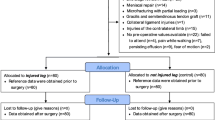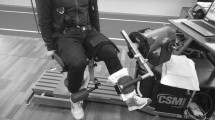Abstract
Purpose
The aim of this study was to evaluate hip muscle flexion strength in patients who underwent anterior cruciate ligament (ACL) reconstruction with patellar or hamstrings tendon graft and compare them with healthy controls.
Methods
Sixty-eight male ACL deficient patients who underwent reconstruction (36 patients with hamstrings tendon graft and 32 patients with patellar tendon graft; randomized selection of type of graft) in our department, between July 2011 and July 2012, were enrolled in this randomised prospective study. Also 64 healthy male weekend athletes participated in the study as a control group. Hip flexor strength was measured by isokinetic dynamometer (Biodex), pre-operatively and one year after reconstruction. The statistical packet STATA 8.0 was used and statistical significance was set at p < 0.05.
Results
Hip flexion strength in ACL reconstructed patients either with patellar tendon or hamstrings grafts, one year after reconstruction is significantly decreased compared to healthy controls (p < 0.0001). Patients reconstructed with patellar tendon have stronger hip flexors than those reconstructed with hamstrings graft (p < 0.0001).
Conclusion
Hip flexion strength remains decreased one year after ACL surgery compared to healthy controls. Patellar tendon could be the graft of choice for ACL reconstruction in athletes who must preserve stronger hip flexors.




Similar content being viewed by others
References
Hiemstra LA, Webber S, McDonald PB et al (2000) Knee strength deficits after hamstring tendon and patellar tendon anterior cruciate ligament reconstruction. Med Sci Sports Exerc 32:1472–1479
Viola RW, Sterett WI, Newfield D et al (2000) Internal and external tibial rotation strength after anterior cruciate ligament reconstruction using ipsilateral semitendinosus and gracilis autografts. Am J Sports Med 28:552–555
Chambat P, Guier C, Sonnery-Cottet B et al (2013) The evolution of ACL reconstruction over the last 50 years. Int Orthop 37(2):181–186
Nakamara N, Horibe S, Sasaki S et al (2002) Evaluation of active knee flexion and hamstring strength after anterior cruciate ligament reconstruction using hamstring tendons. Arthroscopy 18:598–602
Petersen W, Zantop T (2013) Return to play following ACL reconstruction: survey among experienced arthroscopic surgeons (AGA instructors). Arch Orthop Trauma Surg 133(7):969–977
Hiemstra L, Gofton W, Kriellaars D (2005) Hip strength following hamstring tendon anterior cruciate ligament reconstruction. Clin J Sports Med 15(3):180–182
Geoghegan J, Geutions G, Downing N et al (2007) Hip extension strength following hamstring tendon harvest for ACL reconstruction. Knee 14(5):352–356
Karanikas K, Arampatzis A, Brüggemann GP (2007) Graft type-related versus graft type-unrelated ACL treatment: influence on adaptation of muscle strength and motor skills. Z Orthop Unfall 145(5):615–621
Reiman MP, Bolgla LA, Lorenz D (2009) Hip functions influence on knee dysfunction: a proximal link to a distal problem. J Sport Rehabil 18(1):33–46
Karanikas K, Arampatzis A, Brüggemann GP (2009) Motor task and muscle strength followed different adaptation patterns after anterior cruciate ligament reconstruction. Eur J Phys Rehabil Med 45(1):37–45
Karanikas K, Arampatzis A, Brüggemann GP (2004) Development of muscle strength in knee, hip and ankle joints after ACL reconstruction. Sportverletz Sportschaden 18(3):130–135
Vairo GL (2014) Knee flexor strength and endurance profiles after ipsilateral hamstring tendonsanterior cruciate ligament reconstruction. Arch Phys Med Rehabil 95(3):552–561
Pandy M, Shelbourne K (1997) Dependance of cruciate ligament loading on muscle forces and external load. J Biomech 30:1015–1024
Ferrari J, Bush-Joseph C, Bach B (1998) Endoscopic anterior cruciate ligament reconstruction with patellar autograft: surgical technique. Tech Orthop 13:262–274
Scranton P, Pinczewski L, Auld K, Khalfayan E (1996) Outpatient endoscopic quadruple hamstring anterior cruciate ligament reconstruction. Oper Tech Orthop 6:177–180
Gerber P, Marcus R, Dibble L et al (2007) Effects of early progressive eccentric exercise on muscle structure after anterior cruciate ligament reconstruction. J Bone Joint Surg Am 89:559–570
Perrin DH (1993) Terminology and the isokinetic torque curve. In: Perrin H (ed) Isokinetic exercise and assessment. Human Kinetics Publishers, Champaign, pp 13–20
Suomalainen P, Kannus P, Järvelä T (2013) Double-bundle anterior cruciate ligament reconstruction: a review of literature. Int Orthop 37(2):227–232
Barenius B, Webster WK, McClelland J (2013) Hamstring tendon anterior cruciate ligament reconstruction: does gracilis tendon harvest matter? Int Orthop 37(2):207–212
Thomas AC, Villwock M, Wojtys EM, Palmieri-Smith RM (2013) Lower extremity muscle strength after anterior cruciate ligament injury and reconstruction. J Athl Train 48(5):610–620
Jaramillo J, Worrell TW, Ingersoll CD (1994) Hip isometric strength following knee surgery. J Orthop Sports Phys Ther 20(3):160–165
Nozaki D (2009) Torque interaction among adjacent joints due to the action biarticular muscles. Med Sci Sports Exerc 41(1):205–209
Milot MH, Nadeau S, Gravel D, Requião LF (2006) Bilateral level of effort of the plantar flexors, hip flexors, and extensors during gait in hemiparetic and healthy individuals. Stroke 37(8):2070–2075
Siegel KL, Kepple TM, Stanhope SJ (2007) A case study of gait compensations for hip muscle weakness in idiopathic inflammatory myopathy. Clin Biomech (Bristol Avon) 22(3):319–326
Podraza JT, White SC (2010) Effect of knee flexion angle on ground reaction forces, knee moments and muscle co-contraction during an impact-like deceleration landing: implications for the non-contact mechanism of ACL injury. Knee 17(4):291–295
Guex K, Gojanovic B, Millet GP (2012) Influence of hip-flexion angle on hamstrings isokinetic activity in sprinters. J Athl Train 47(4):390–395
Li G, Defrate LE, Rubash HE, Gill TJ (2005) In vivo kinematics of the ACL during weight-bearing knee flexion. J Orthop Res 23(2):340–344
Conflict of interest
None declared.
Author information
Authors and Affiliations
Corresponding author
Rights and permissions
About this article
Cite this article
Mouzopoulos, G., Siebold, R. & Tzurbakis, M. Hip flexion strength remains decreased in anterior cruciate ligament reconstructed patients at one-year follow up compared to healthy controls. International Orthopaedics (SICOT) 39, 1427–1432 (2015). https://doi.org/10.1007/s00264-014-2662-x
Received:
Accepted:
Published:
Issue Date:
DOI: https://doi.org/10.1007/s00264-014-2662-x




